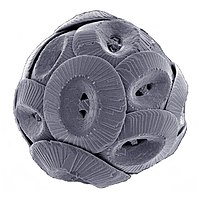
Photo from wikipedia
The mechanical properties of biologic scaffolds are critical to cellular interactions and hence functional response within the body. In the case of scaffolds for bone tissue regeneration, engineered scaffolds created… Click to show full abstract
The mechanical properties of biologic scaffolds are critical to cellular interactions and hence functional response within the body. In the case of scaffolds for bone tissue regeneration, engineered scaffolds created by combining collagen with inorganic mineral are increasingly being explored, due to their favourable structural and chemical characteristics. Development of a method for controlling the mechanics of these scaffolds could lead to significant additional advantages by harnessing the intrinsic mechnotransduction pathways of stem cells via appropriate control of scaffold mechanical properties. Here we present a method for controlling the macroscale flexural modulus of mineralized collagen sheets, and the radial indentation modulus of the sheets' constituent collagen fibrils. Scaffolds were created starting with sheets of highly aligned, natively structured collagen fibrils, prepared via cryosectioning of decellularized tendon. Sheets underwent an alternate soaking mineralization procedure, with sequential exposure to citrate-doped calcium and carbonate-containing phosphate solutions, both of which included poly aspartic acid. The extent of scaffold mineralization was controlled via number of repeated mineralization cycles: 0 (unmineralized), 5, 10, and 20 cycles were trialed. Following scaffold preparation, ultrastructure, macroscale flexural modulus, and nanoscale indentation modulus were assessed. Surface architecture studied by SEM, and inspection of individual extracted fibrils by TEM and AFM confirmed that fibrils became increasingly laden with mineral as the number of mineralization cycles increased. Measurements of collagen fibril nanomechanics using AFM showed that the radial modulus of collagen fibrils increased linearly with mineralization cycles completed, from 215 ± 125 MPa for fibrils from unmineralized (0 cycle) scaffolds to 778 ± 302 MPa for fibrils from the 20 mineralization cycle scaffolds. Measurements of scaffold macromechanics via flexural testing also showed a linear increase in flexural modulus with increasing number of mineralization cycles completed, from 18 ± 7 MPa for the 5 cycle scaffolds to 156 ± 50 MPa for the 20 cycle scaffolds. The process detailed herein provides a way to create mineralized collagen scaffolds with easily controllable mechanical properties.
Journal Title: Journal of the mechanical behavior of biomedical materials
Year Published: 2020
Link to full text (if available)
Share on Social Media: Sign Up to like & get
recommendations!